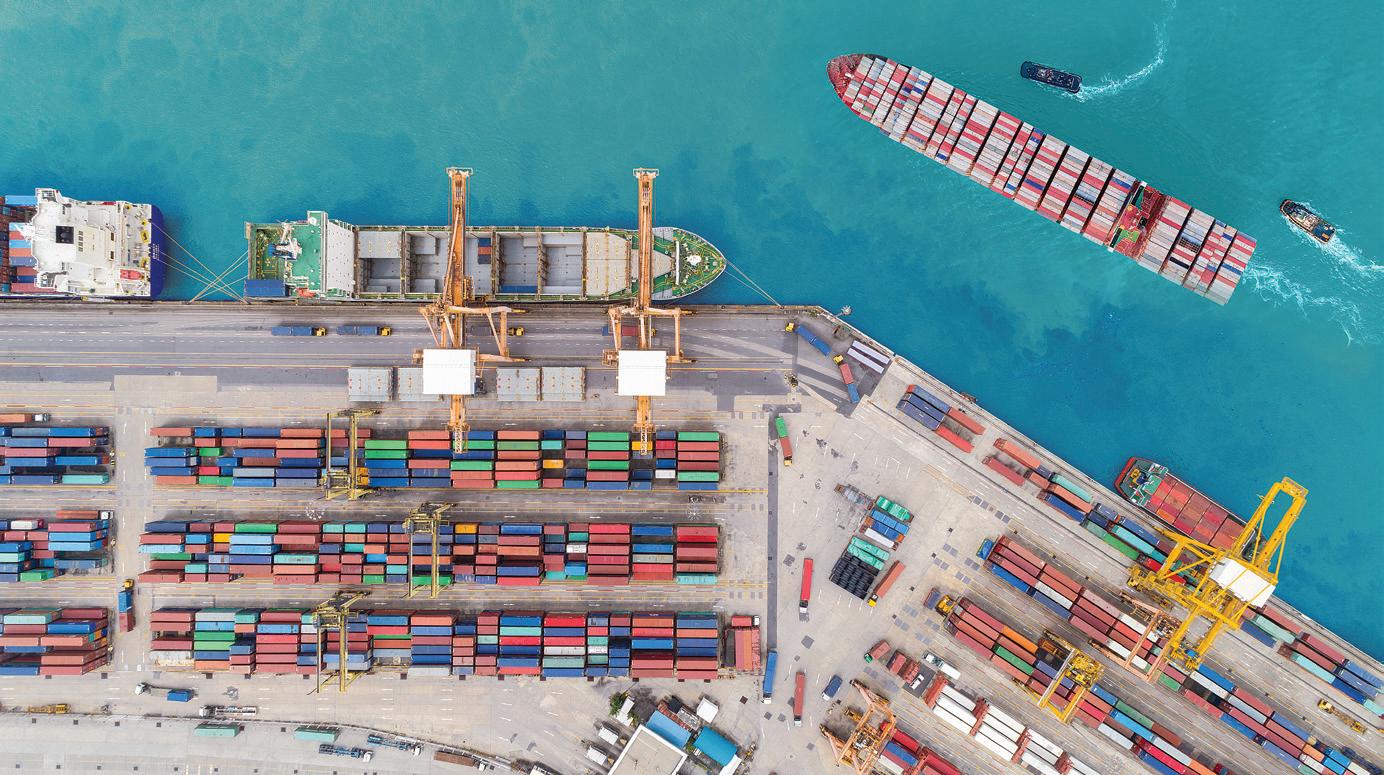
3 minute read
IMO 2023 AND THE CURRENT STATE OF OCEAN FREIGHT
Shipping cargo across oceans has hit an evolutionary status as new rules and regulations continue to expand. Meeting the call for disruption, new practices have been compounded upon to improve efficiency and transform the state of transportation to a level above. IMO 2023, a part of the International Maritime Organization’s Greenhouse Gas Strategy, is a series of regulations that look to reduce carbon emissions of all ships by 40% by 2030, and further to 70% by 2050.
In simple terms, Charles Kim, senior journalist at OPIS by IHS Markit, and Yanyu He, executive director, natural gas liquids research at S&P Global Commodity Insights, says a ship running on a low carbon fuel receives a higher rating than one running on high carbon fuel.
“The first rating will be given to each ship in 2024, based on the CII of the ships recorded in 2023, with a 5% improvement required vs. the 2019 baseline figure. In practical terms, the race is already on. After 2023, ship owners must seek ways to improve CII of their ships constantly, as a 2% incremental improvement is required each year through 2026 to meet the 11% carbon intensity reduction target for international shipping for 2026 vs. 2019,” according to Kim and He.
What is IMO 2023 comprised of?
The implementation of IMO 2023 is set to make major changes. Through utilizing energy efficiency indicators such as the Energy Efficiency Existing Ship Index (EEXI), the Ship Energy Efficiency Management Plan (SEMP) and a vessel’s Carbon Intensity Indicator (CII), commercial and non-commercial vessels are subject to a mandatory reduction in carbon emissions.
And what do each of these indicators do exactly?
“EEXI is a rating system that assesses the energy performance of existing ships based on energy consumption data and other key metrics such as speed, power and engine size,” according to a DHL report. “Non-compliant vessels that receive an EEXI rating below a certain threshold may be subject to IMO 2023 penalties and restrictions and need to make modifications to engines or systems.”
As a ship-specific plan, SEEMP is document that lays out the plan to improve a vessel’s energy efficiency in a costeffective way. Although each one is unique to each ship, the plans should be laid out with practicality that allows owners and operators to manage operations and improve those efficiency parameters over time. CII is a new global shipping carbon intensity level indicating tool used to rank and monitor the efficiency of individual ships. It links together the GHG emissions, and the amount of cargo carried, along with the distance travelled ratio. The DHL ocean freight report explains that the CII rating threshold will become stricter over time and will determine the annual carbon reduction factor needed to ensure compliance. Starting this year, every vessel will receive a grade from A-E and ships with three years of D grades or one year of an E grade will be put into a corrective action plan.

Knowing the details
Compliance isn’t one size fits all. Each of these components has their own set of steps to follow in order to achieve success. For EEXI, compliance is found after passing an assessment.
“Under the new measures, all ships of 400 gross tonnage (GT) and above will be required to have their Energy Efficiency Existing Ship Index (EEXI) calculated with certain requirement of improvement in energy efficiency varying by the size and type of ships,” says Kim and He. “For gas carriers, ships of 10,000 deadweight tons (DWT) and above are required to have improved their technical energy efficiency by 30% vs. a 2013 reference line and each ship is required to have achieved the required efficiency level to get their one-off International Energy Efficiency Certificate re-issued at their first ship survey on or after Jan. 1, 2023. Failure to meet the required standard would lead to the vessels unable to be used for international trade.”
By the end of 2022, it was required that a determination was to be made about a ship’s carbon intensity via a SEEMP, organizing and preparing the necessary plan that improves the ship’s efficiency through tech and other operational improvements that make an impact. BDP International described the prep work they’ve seen in ocean freight where “many efficiency improvements and emissions reduction pathways are being executed by carriers, such as hull cleaning to reduce drag, steam speed adjustment, routing optimization and fuel switching.”
Investments in energy efficient technology will help aid owners and operators with compliance with all IMO 2023 regulations. Unfortunately, more costs in energy efficiency might bring higher overall shipping costs and to reduce fuel consumption, and improve efficiency further, shipping speeds may slow down.
The operation of older vessels could be hindered by detaining them for modifications that meet the requirements; with Kim and He describing the most common modifications being the installation of energy saving devices, or to install Engine Shaft Power Limitation (ShaPoli) and/or Engine Power Limitation (EPL) system, “which is used to lower the maximum speed of the vessels.” And, this could have a negative effect on overall shipping capacity.
The premise of IMO 2023 is a true promotion of greater energy efficient efforts and a positive step in ocean freight. The key to reaching compliance comes from good research and a focus of preparedness along the way.


“The speed of advancement in technology will need to keep pace with tighter regulations by IMO going forward. With rapid tightening of regulations expected to continue over the coming decades, research efforts will need to remain robust,” explains Kim and He.
But overall, the potential pitfalls of delays and higher cost are small in the scope of sustainability.
Learn more details about compliance here: https://foodl.me/go0xxm









